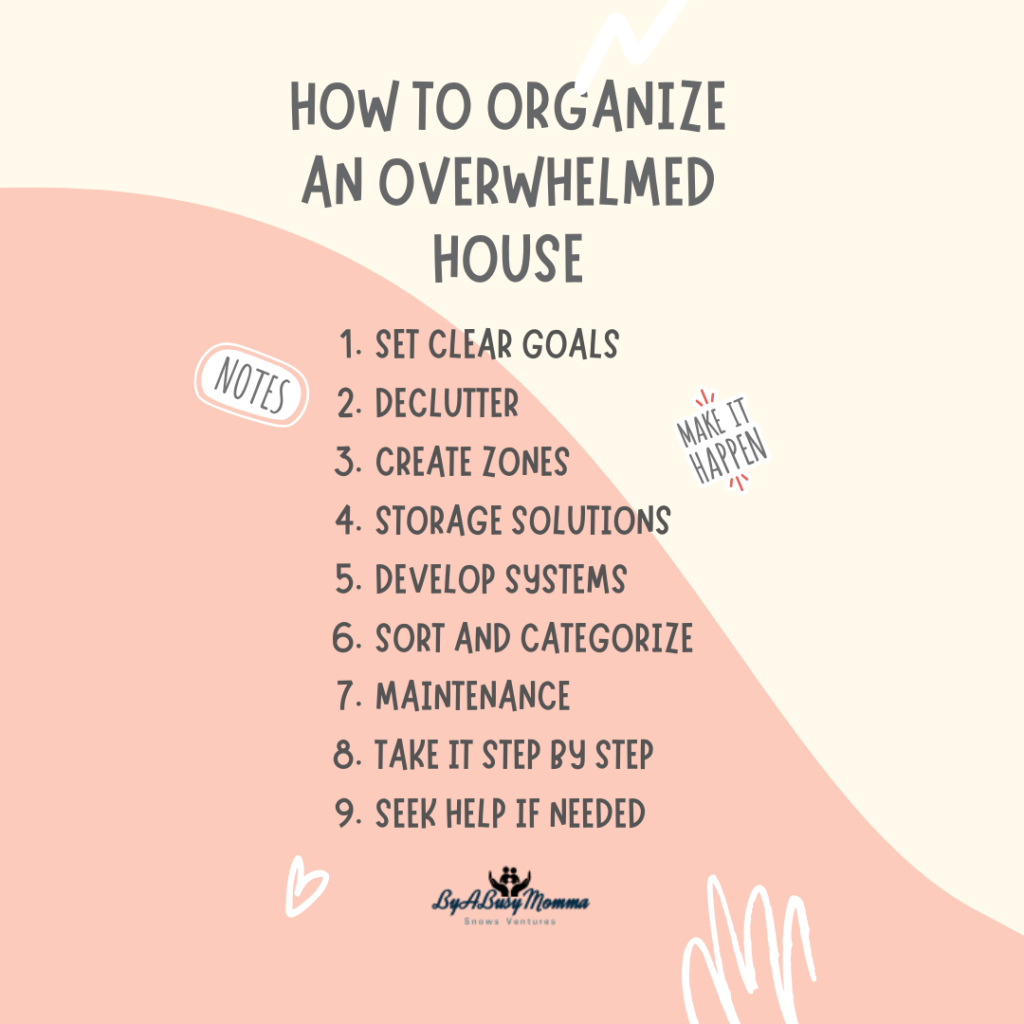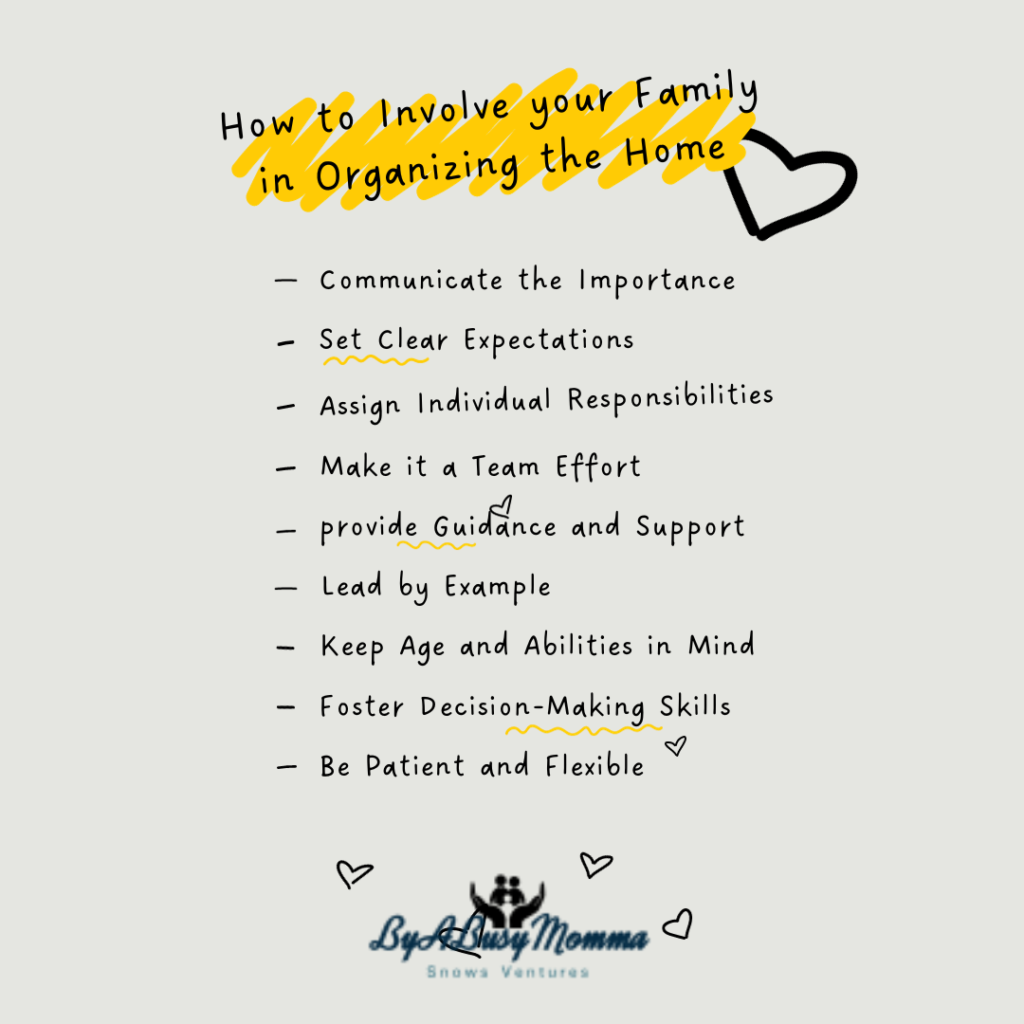Organizing an overwhelmed house can feel daunting, but breaking it down into manageable steps can make it more achievable.

Check out these great books on Amazon that teach organization skills for your home.
Also, these great organization tools:

Here’s a step-by-step approach to getting started:
- Set Clear Goals: Begin by defining your organizing goals. Determine what areas or rooms you want to tackle first and what specific outcomes you want to achieve. For example, you might prioritize decluttering the living room and creating an organized workspace.
- Declutter: Decluttering is a crucial first step in organizing an overwhelmed house. Go through each room and sort items into categories: keep, donate/sell, and discard. Be honest about what you truly need and use, and let go of things that no longer serve a purpose or bring you joy. Start with a tiny area or category at a time to avoid feeling overwhelmed.
- Create Zones: Divide each room into functional zones based on the activities in those areas. For example, designate a specific area for relaxation, work, storage, and play. This helps establish clear boundaries and makes it easier to maintain organization in the long run.
- Establish Storage Solutions: Assess your storage needs and invest in appropriate solutions. This might include bins, baskets, shelves, drawer dividers, or storage furniture. Choose answers that fit the size and style of your space and help maximize storage capacity while keeping items easily accessible.
- Develop Systems: Develop simple systems to keep belongings organized. Assign specific places for items based on their frequency of use and category—label containers, shelves, or drawers to clarify where things belong. Involve your family members in creating these systems to ensure everyone understands and can contribute to maintaining the organization.
- Sort and Categorize: Sort and categorize items within each zone or room. Group similar items together, such as books, electronics, or toys. This allows for easier retrieval and helps you identify duplicates or excess items that can be further decluttered.
- Prioritize Maintenance: Establish daily habits and routines to maintain the organization. Encourage family members to clean up and return items to their designated places. Schedule regular decluttering sessions to prevent the accumulation of unnecessary items.
- Take it Step by Step: Organizing an overwhelmed house is not a one-time task. Take it one step at a time, and be patient with yourself. Start with the areas that bother you the most or significantly impact your daily life. Celebrate small victories along the way to stay motivated.
- Seek Help if Needed: If you feel overwhelmed or need assistance, don’t hesitate to seek help. This might involve hiring a professional organizer or involving family members and friends in the organizing process. An outside perspective or additional hands can make a significant difference.
Remember, organizing is a continuous process, and it’s normal to have setbacks or moments of frustration. Be flexible and open to adjusting your systems as needed. You can transform an overwhelmed house into a well-organized and functional home with consistent effort and a commitment to maintaining organization.

Involving your family members in organizing can foster a sense of ownership, teamwork, and shared responsibility. Here are some strategies to get your family involved:
- Communicate the Importance: Explain to your family members why organizing is essential. Discuss the benefits of an organized space, such as reduced stress, improved efficiency, and a more pleasant living environment. Help them understand that organizing is a shared responsibility that benefits everyone.
- Set Clear Expectations: Communicate your expectations regarding organization and cleanliness. Establish specific guidelines or rules for each family member to follow. For example, establish a rule that toys should be put away after playtime or that dishes should be washed immediately after use. Make sure everyone understands the expectations and consequences of not following them.
- Assign Individual Responsibilities: Give each family member specific organizing responsibilities based on age and abilities. Assign tasks such as making the bed, tidying their rooms, or managing particular house areas. By assigning individual responsibilities, everyone has a role to play in maintaining the organization.
- Make it a Team Effort: Organizing can be a fun and bonding activity as a family. Schedule regular family organizing sessions where everyone simultaneously works on a specific area or task. Play upbeat music, set a timer, and turn it into a friendly competition or challenge. Working together not only speeds up the process but also strengthens family connections.
- Provide Guidance and Support: Teach your family members organizing skills and techniques. Show them how to sort items, use storage solutions, and maintain order. Offer guidance and support when they need assistance. You empower them to take responsibility for their spaces by teaching them the necessary skills.
- Lead by Example: Be a role model for organization. Maintain your own spaces and belongings and follow the established guidelines. When your family members see you practicing what you preach, they are likelier to adopt similar habits. Your actions speak louder than words.
- Make it Fun and Rewarding: Find ways to make organizing enjoyable and rewarding for your family. Set small milestones or goals and celebrate achievements together. When specific managing tasks are completed, offer rewards or incentives, such as a family outing or a special treat. This creates positive associations with organizing and motivates everyone to participate.
- Keep Age and Abilities in Mind: Consider the age and abilities of your family members when involving them in the organizing process. Younger children may need more straightforward tasks and guidance, while older children and teenagers can handle more complex organizing projects. Tailor the duties and expectations to suit each individual’s capabilities.
- Foster Decision-Making Skills: Encourage your family members to make decisions about their belongings. Teach them to evaluate items based on usefulness, sentimental value, and personal preferences. Help them understand the concept of letting go of things that are no longer needed or bring clutter to their spaces.
- Be Patient and Flexible: Remember that organizing is a skill that takes time to develop. Be patient with your family members, especially if they are new to organizing or struggle to maintain order. Offer encouragement and support, and be flexible in adjusting systems or strategies as needed.

By involving your family members in the organizing process, you create a sense of shared responsibility and promote a culture of organization within your household. Collaboration and teamwork make the process more enjoyable and sustainable in the long run.
